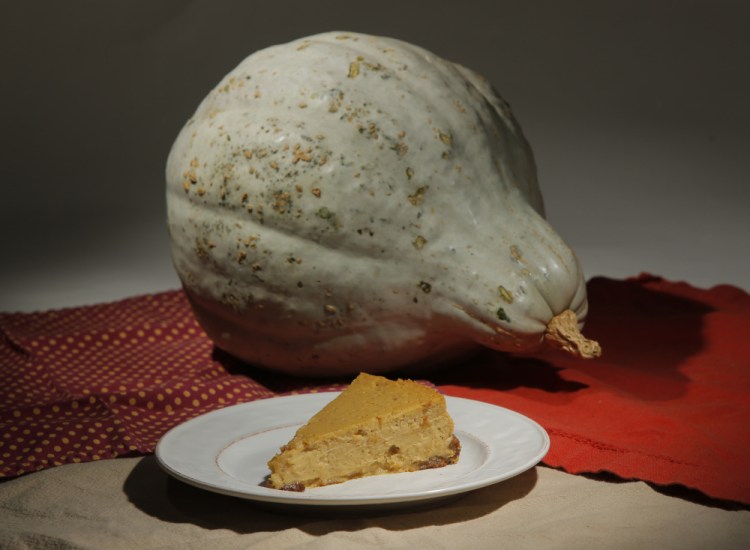I know how to use all the bits of a 25-pound Thanksgiving turkey. That’s easy. You let the dozen or so 6-foot-plus men and boys in your life have at it and then you simmer the picked-over carcass for soup. But a 25-pound Blue Hubbard squash? For a cook concerned with not wasting food, that’s a more menacing monster to slay for the holiday buffet.
“The Hubbard is the dinosaur of the squash world: big, primordial and ungainly, with a swollen middle,” Deborah Madison writes in her book “Vegetable Literacy.” But despite its warty, grayish diplodocus-like appearance, this giant’s deep orange starchy flesh is “fine textured, sweet and rich,” she writes, making it a great ingredient for everything from soup to cheesecake (see recipe).
Unless you are feeding a strictly vegetarian army with one of these squashes, which range in size from 8 and 40 pounds, it’s best to take the cook-once, use-many-times approach I espoused last year to use up a whole Hubbard.
When you pick out any winter squash, look for one that is rock hard and free from bruises or soft spots. You want it to be heavier than it looks, an indication that the flesh is supple and not dried out. And the stem should be attached, so bacteria does not have an opening to invade the flesh should you be spurred to buy one by this column, but run out of time to execute the following process and have to store it in a cool, dark place for up to 6 months. It will only get sweeter as it sits until you have the time to deal with the beast.
Cracking open an enormous Blue Hubbard can seem daunting. You can soften the skin a bit by pricking the squash and baking it for 10 minutes in a 350 degree Fahrenheit oven. To make the first cut, set the squash on a towel-lined cutting board to prevent slippage. Knock the stem off with the dull side of a heavy chef’s knife.
Then, starting with the tip of your knife set in the center of the squash, cut lengthwise through half of the squash. Rotate the squash and cut through the other side. Scrape the seeds and stringy bits away from the flesh.
Mix the pulp and seeds in a pot with 3 cups of water and simmer for 10 minutes (longer could make the mixture bitter) to make a broth to flavor soups, risottos and salad dressing (1/2 cup squash broth plus 2 tablespoons each of tahini, honey and olive oil, seasoned with salt and pepper, makes a good one). The seeds can be rinsed, separated easily from the stringy pulp – which gets composted at this point – and roasted using your favorite pumpkin seed recipe.
Cut the squash into 2-inch wide strips and roast them, flesh side up, in a 375 degree Fahrenheit oven until you can easily send a fork through the thickest part of the thickest wedge, 45 to 60 minutes. I typically roast the squash naked (the squash, not me), so I can use it in either sweet or savory recipes. Cool the roasted wedges for 20 minutes and then scrape the flesh into a bowl and mash it until smooth.
From here, you can have your way with the puree. Swap it into a sweet potato roll recipe, stir it into a soup as an interesting thickener, combine it with butter and cream and whip it up as a decadent side dish, or pack it tightly into containers to be stored in the freezer for up to 3 months.
My little 10-pound Blue Hubbard yielded 31/2 cups of mash, 3/4 pound of roasted seeds and 2 cups of broth while leaving less than a pound of skin and spent stringy bits to toss into the compost bucket. So I’m no longer afraid of these monster squashes.
But if you are still wary, try a Baby Blue, a family-sized Hubbard cultivated to weigh in between 4 and 6 pounds. The same preparation techniques apply, but cooking one of these little guys is not nearly as fun as slaying the monster squash and having the spoils of victory for pie.
Christine Burns Rudalevige is a food writer, a recipe developer and tester, and a cooking teacher in Brunswick. Contact her at: cburns1227@gmail.com.
Send questions/comments to the editors.




Comments are no longer available on this story